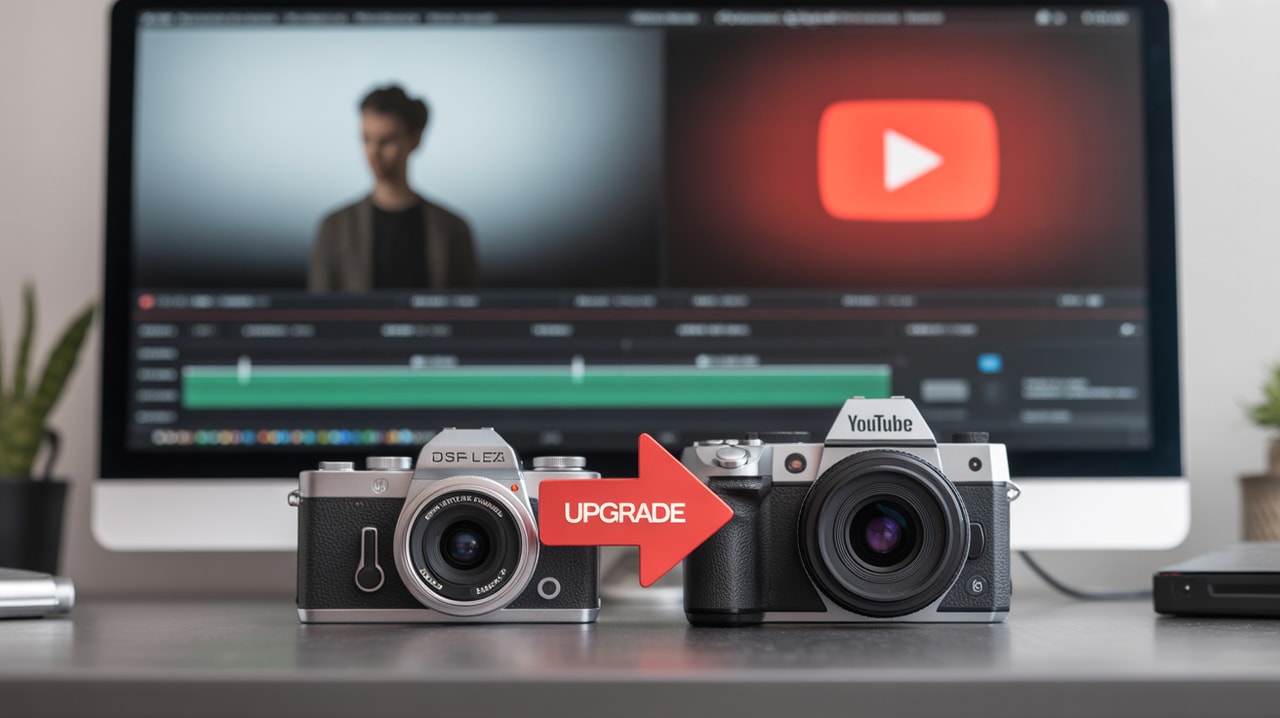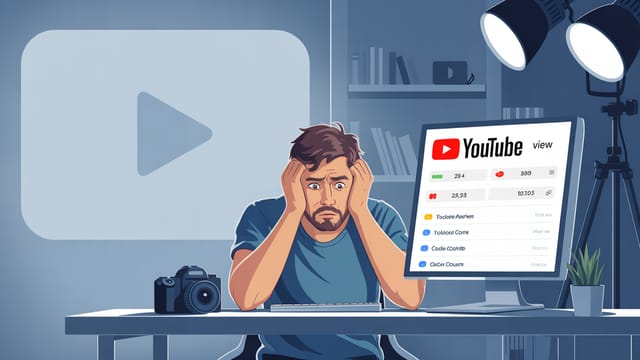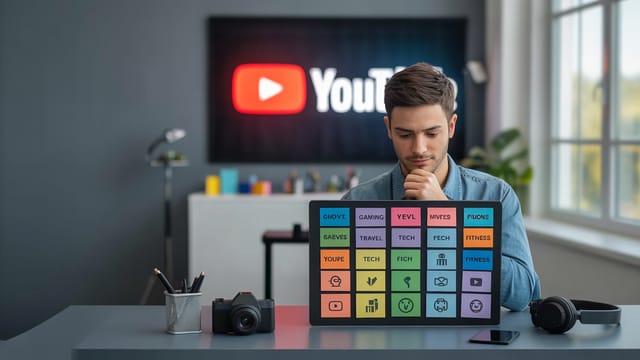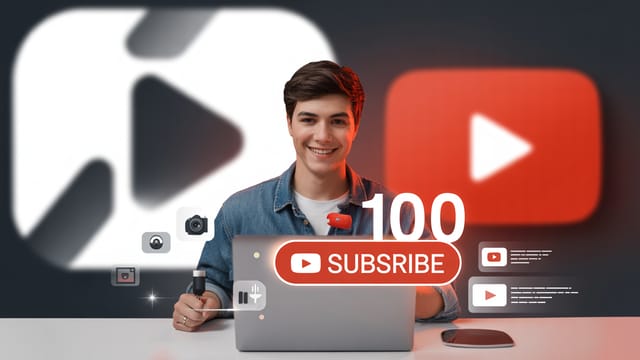
Ready to get your next 10,000 subscribers?
Join thousands of creators who use Subscribr to create faster, better YouTube videos.
When Should I Upgrade My YouTube Camera? (A Clear Guide)
Deciding when to invest in new camera gear is one of the biggest questions facing growth-focused YouTubers. You see your favorite creators with their fancy setups, and it’s easy to think a better camera is the magic bullet for more views and subscribers. But is it really holding you back? Or is it a case of "gear acquisition syndrome" distracting you from what truly matters?
This guide will cut through the confusion and give you a strategic framework for deciding if, when, and what camera upgrade makes sense for your YouTube journey in 2025. We'll look at it through the lens of smart investment with a clear Return on Investment (ROI) focus.
Is Your Current Camera Really the Problem?
Before you drop serious cash on new equipment, it's crucial to honestly assess if your current camera is the actual bottleneck preventing your channel's growth. As many YouTube strategists point out, especially for newer creators, investing in knowledge and strategy is often far more impactful than buying expensive gear. High production value is less critical than delivering high-quality content value.
Think about it: You've likely watched videos with less-than-perfect camera quality that still kept you hooked. That's because the creator nailed the idea, the storytelling, the hook, and the editing. The YouTube algorithm itself defines quality not by the camera model, but by how viewers engage with your video – metrics like audience retention, watch time, and click-through rate (CTR). A technically perfect video with a weak idea or poor pacing won't perform as well as a video with a compelling story and great audio, even if the video quality is just "good enough."
However, there are signs your current camera might genuinely be limiting your potential:
- Poor Low Light Performance: Your footage looks grainy or muddy unless you're in perfect lighting conditions.
- Lack of Essential Features: You can't connect an external microphone (crippling for audio!), can't shoot in frame rates needed for slow-motion, or lack features like a flip-out screen that help with vlogging or solo shooting.
- Workflow Bottlenecks: Transferring footage is painfully slow, or your computer struggles to edit the files your camera produces, eating up valuable time.
- Inconsistent or Unprofessional Look: Despite your best efforts with lighting and settings, your image quality consistently looks unprofessional compared to others in your niche.
If you're consistently struggling with these issues, an upgrade might be a strategic move.
Strategic Gear Upgrades: A Tiered Approach to Investing
Instead of thinking of camera upgrades as simply "getting a better camera," view it as investing in your channel's future with an eye on ROI. What return will this investment bring? Will it save you time, improve quality in a way your audience values, or enable new content formats that lead to growth or monetization?
Here's a tiered approach to consider, building upon your existing setup:
Tier 1: Mastering the Smartphone Setup
Many successful creators start and even continue using just their smartphone. Modern phones shoot incredible video, especially in good light.
- When it's enough: You're just starting out, your content is primarily talking head or simple vlogs, and your lighting and audio solutions are already decent.
- Smart Investments at this stage: Don't upgrade the phone yet. Instead, invest in accessories that dramatically improve quality and workflow:
- Audio: A good lavalier mic or shotgun mic that plugs into your phone is essential. Viewers tolerate average video much more than bad audio.
- Lighting: A simple ring light or LED panel can make a huge difference in image quality, even with a phone camera.
- Stability: A tripod or gimbal for steady shots.
Tier 2: The Desktop/Webcam Upgrade
If your content primarily involves sitting at a desk – like tutorials, interviews, streaming, or podcasting – investing in a high-quality webcam or using a dedicated camera as a webcam might be the smart move.
- When to consider: Your computer's built-in webcam is poor, and you need a significant step up in quality for seated content without needing portability.
- Setup: This often involves a good quality webcam (like a Logitech Brio) or connecting a mirrorless/DSLR camera via a capture card (like the Elgato Cam Link). Pair this with a good desk microphone and lighting.
Tier 3: Investing in a Dedicated Camera
This is the traditional "camera upgrade" step, moving to a mirrorless or DSLR camera.
- When it's justified: You've outgrown the limitations of your smartphone or webcam setup. You need better low-light performance, the ability to change lenses for different shots (cinematic depth of field, wide shots), better audio inputs, higher frame rates, or more control over your image.
- Smart Investments at this stage: Don't just buy the camera body. Allocate your budget strategically:
- Camera Body: Choose a camera known for good video features in your price range (e.g., Sony ZV series, Canon R series, Fujifilm X series).
- Lenses: Often, a good lens makes a bigger difference than the camera body itself. A fast prime lens (like a 50mm f/1.8) can give you that blurred background look.
- Audio: Continue to prioritize high-quality microphones (shotgun, wireless, or lav).
- Lighting: Invest in versatile lighting setups.
- Support: Sturdy tripods, gimbals, or sliders.
- Computer: Ensure your editing machine can handle the larger files and higher demands.
Specialty Gear
This tier is for cameras designed for specific use cases, like action cameras (GoPro), drones, or 360 cameras.
- When it's justified: Only if your content specifically requires this type of footage (e.g., extreme sports, aerials, immersive experiences). These are usually additions to your main setup, not your primary camera.
The Right Time to Upgrade: More Than Just Specs
So, when exactly is the right time to pull the trigger on an upgrade? It's not just about a new model coming out. It's about aligning the investment with your channel's strategic needs and momentum.
- After Initial Success or Momentum: As suggested by YouTube strategists, when a video or series starts to take off and show real momentum, it's a sign that your content is resonating. This is a good time to reinvest some of that momentum (and potential revenue) back into the channel, starting with areas like camera quality if it's a clear limitation.
- When Your Camera Hinders Your Workflow: If you're losing significant time dealing with slow file transfers, camera reliability issues, or lack of features that would streamline your shooting or editing process, an upgrade can have a direct ROI in saved time. Setting up a dedicated filming station with your new gear, for example, can eliminate setup time for every video, as noted by strategy experts.
- When Your Content Vision Exceeds Your Gear: If you have specific creative ideas (like cinematic shots with shallow depth of field, high-quality slow motion, or complex lighting setups) that your current camera simply cannot achieve, and these ideas are crucial to your content's evolution and audience value, it might be time.
- When the Quality Gap is Obvious and Impacts Viewer Experience: If viewers consistently comment on poor video quality (beyond just wanting 4K for the sake of it), or if your competitors' production quality is significantly higher in a way that impacts watchability (e.g., better low light in nighttime vlogs), an upgrade could be necessary to stay competitive.
Ultimately, ask yourself the key questions: Will this upgrade genuinely help me save time? Will it help me make more money, either directly (client work) or indirectly (better brand perception, higher monetization)? Is this a true need based on my content goals and audience feedback, or just a want?
Beyond the Camera Body: Where Else to Invest
It bears repeating: the camera body is only one part of the equation. Often, upgrading your audio, lighting, and lenses will provide a much more noticeable improvement in overall video quality and viewer experience than just getting the latest camera body.
A video with great audio and decent visuals is far more watchable than a video with stunning 4K footage but terrible, echoey audio. Similarly, good lighting can make even a smartphone camera look professional, while poor lighting will make an expensive camera look bad. Investing in versatile lenses allows you to achieve different looks and adapt to various shooting situations, which can be crucial for storytelling.
Don't forget the importance of a capable computer for editing. High-quality video files require processing power. If your computer is a bottleneck, even the best camera footage will be a frustrating experience.
Making the Decision & Avoiding "Gear Acquisition Syndrome"
The world of camera gear is vast and constantly evolving, making "gear acquisition syndrome" (GAS) a real risk. It's easy to get caught up in reviews and comparisons, spending hours researching gear instead of creating content. Remember the opportunity cost here – that time could be spent brainstorming ideas, scripting, filming, or editing, all of which have a more direct impact on growth than endlessly debating camera specs.
Prioritize learning how to use the gear you have effectively before buying more. Understanding composition, lighting principles, audio recording techniques, and editing fundamentals will elevate your videos regardless of the camera.
When you are ready to make a significant investment, consider renting the equipment first to see if it truly fits your workflow and needs. Buying used gear can also be a cost-effective way to upgrade. And remember to look into potential tax write-offs for business expenses related to your channel – consult with a CPA on this.
As your channel grows and you invest in better gear, you might also find opportunities to monetize that equipment, perhaps by doing freelance video work or through affiliate marketing, recommending the gear you use to your audience.
Tools & Resources
Making strategic decisions about your YouTube channel, including when and what gear to upgrade, requires data and insight. This is where tools like Subscribr can be invaluable.
Instead of guessing if your camera is the issue, Subscribr's Channel Intelligence system can help you analyze your performance metrics, like audience retention and view velocity. Are viewers dropping off early? It might be a hook, pacing, or audio issue, not just video resolution. Are your videos not getting clicks? It could be your titles or thumbnails, areas where Subscribr offers Title Generation and Thumbnail Brief Creator tools.
You can use Subscribr's Video Breakdown Tool to analyze successful videos in your niche (like high-view cinematic vlogs you find using Video Search) to understand their production quality, pacing, and structure, giving you realistic benchmarks for your own content. The Research Assistant can help you gather information on specific gear you're considering, integrating web search into your planning process.
By focusing on the strategic aspects of content creation, audience understanding, and performance analysis within Subscribr, you can make more informed decisions about where your investments – both time and money – will have the biggest impact on your growth.
Conclusion
Upgrading your YouTube camera is a significant decision that should be driven by strategy, not just the desire for new gadgets. The best time to upgrade is when your current camera is a clear technical bottleneck hindering your workflow or preventing you from creating the kind of content your audience wants and that aligns with your creative vision.
Prioritize mastering the gear you have, investing in crucial elements like audio and lighting first, and treating camera upgrades as a tiered investment with an expected ROI. By focusing on delivering high-quality content value and making strategic decisions based on your channel's actual needs and performance, you'll ensure that your camera is a tool that empowers your storytelling, not just an expensive piece of equipment.





